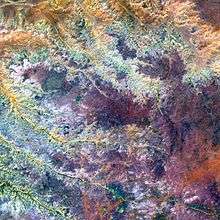VNIR

A VNIR image of the Ghadamis River in Libya. This is a false-color composite image made using near-infrared, green, and blue wavelengths.
The visible and near-infrared (VNIR) portion of the electromagnetic spectrum has wavelengths between approximately 400 and 1400 nanometers (nm).[1] It combines the full visible spectrum with an adjacent portion of the infrared spectrum up to the water absorption band between 1400 and 1500 nm. Some definitions also include the short-wavelength infrared band from 1400 nm up to the water absorption band at 2500 nm.[2] VNIR multi-spectral image cameras have wide applications in remote sensing and imaging spectroscopy.[3]
See also
- Advanced Spaceborne Thermal Emission and Reflection Radiometer
- Airborne Real-time Cueing Hyperspectral Enhanced Reconnaissance
- Mars Reconnaissance Orbiter
- Near infrared spectroscopy
References
- ↑ Moseley, Trevor & Zabierek, Gus (2006). "Guidance On The Safe Use Of Lasers In Education And Research" (PDF). Archived from the original (PDF) on 2007-08-24. Retrieved 2007-10-31.
electromagnetic radiation at wavelengths extending from 100 nm in the ultra-violet, through the visible (400-700 nm), and the near infrared (700-1400 nm), to the far infrared (1400 nm – 1 mm).
- ↑ Waiser, T.H.; Morgan, C.L.S.; Brown, D.J.; Hallmark, C.T. (2007). "In Situ Characterization of Soil Clay Content with Visible Near-Infrared Diffuse Reflectance Spectroscopy". Soil Science Society of America Journal. 71 (2): 389. doi:10.2136/sssaj2006.0211.
- ↑ Ben-dor, E.; Inbar, Y.; Chen, Y. (1997). "Reflectance spectra of organic matter in the visible near-infrared and short wave infrared region(400-2500 nm) during a controlled decomposition process" (PDF). Remote Sensing of Environment. 61 (1): 1–15. doi:10.1016/S0034-4257(96)00120-4. Archived from the original (– Scholar search) on May 9, 2006. Retrieved 2007-10-31.
This article is issued from Wikipedia - version of the 9/10/2016. The text is available under the Creative Commons Attribution/Share Alike but additional terms may apply for the media files.